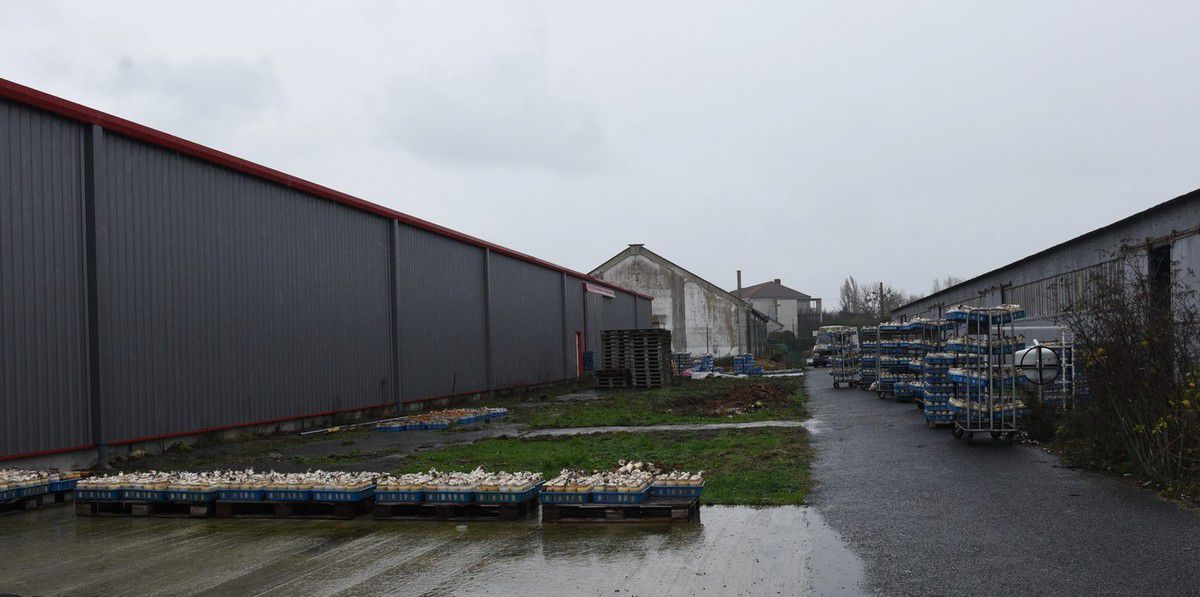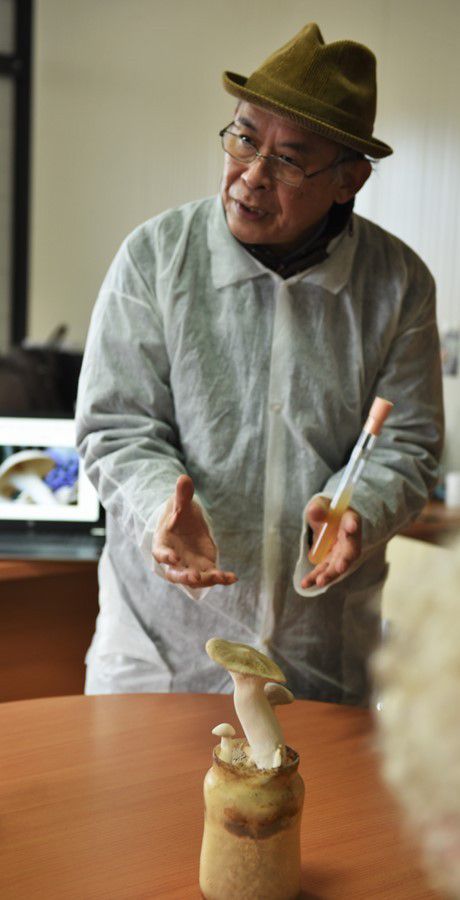A couple of weeks ago, on a really miserable blustery wet day I drove over to Nouâtre on the Vienne to meet other members of the Association de botanie et de mycologie de Sainte Maure de Touraine. Nouâtre, in case you don't know it, is home to a ginormous army base used as a materiels repair, storage and supply hub. It used to be bigger and the part that is no longer in use by the military is an industrial estate. We were off there to visit Bio-Champi, a company producing half a dozen organically grown species of mushrooms for the pharmaceutical industry, but (not yet) for culinary purposes.
Mushrooms growing outdoors.
 |
| Photo courtesy of Louisette Chaslon. |
The business was established 15 years ago by Chinese born microbiologist Guanglai Zhang and they specialise in cultivating rare species using a Japanese technique that no one else in Europe is using. The mushrooms are grown in transparent plastic pots, which in earthquake prone Japan mean that you do not lose your crop when the ground trembles. The clear pots also mean that any contamination by diseases can be seen early.
There are machines made for the various processes involved in the cultivation and designed specifically to deal with these plastic pots. The polypropylene pots are sterilised in autoclaves and can be reused 18 times, which makes them eco-friendly.
White Ferula Mushroom Pleurotus eryngii var nebrodensis
growing in its special Japanese pot.
 |
| Photo courtesy of Louisette Chaslon. |
The species we focused on for our visit was the White Ferula Mushroom Pleurotus eryngii var nebrodensis (Fr. Pleurote du panicaut).
There are thirty species of Pleurotus (oyster mushrooms) which are grown commercially. The best known is the Grey Oyster Mushroom P. ostreatus, which you can buy in almost any supermarket these days, but the most highly prized is the White Ferula Mushroom. The variety P. e. ferulae (White Elf Mushroom) is found in the wild in France, associated with thistles, and recognisable by its slimmer stem. Another well known variety is the King Oyster Mushroom P. e. eryngii, which has a bigger slightly paler cap.
Guanglai Zhang, holding a tube of mycelium.
 |
| Photo courtesy of Louisette Chaslon. |
Four varieties of P. eryngii are native to Europe and one to China, all growing at different altitudes above sea level. All are edible. The rarest is P. eryngii var nebrodensis, the White Ferula Mushroom, growing in the wild only in the high rocky mountains of Sicily (1200 - 2000 m), where it is always associated with the umbellifer Cachrys ferulacea. It is also one of the top ten most highly sought after edible mushrooms in the world. Although it is Red Listed there is no protective legislation in place and it can still be harvested in the wild. Consequently, it is believed that fewer than 250 mushroom fruiting bodies per year reach maturity in the wild due to over harvesting and the picking of immature mushrooms. Bio-Champi is therefore developing and refining a method of cultivation for the species, to supply the culinary and medicinal demand and take the pressure off the wild population. They also grow the ordinary Grey Oyster Mushroom at their facility.
The thick stem is diagnostic for P. eryngii var nebrodensis, and many mushrooms on the market purporting to be this species turn out to be one of the other more common varieties of P. eryngii. This species is heat and cold resistant, making a crusty cracked skin on its cap in hot weather, as the flesh grows more quickly than the skin. This cracked skin is a sign of the best quality with the most flavour. The mushrooms will appear in the wild in April-May and September-October.
Showing us the outdoor mushrooms.
 |
| Photo courtesy of Louisette Chaslon. |
The White Ferula Mushroom P. eryngii var nebrodensis is also associated with another umbellifer, Sea Holly Eryngium spp. In Spain the mushroom is cultivated outdoors in rows of Sea Holly but it is a lot of work and the crop is plagued by disease. The aim of the cultivation and research at Bio-Champi is to select strains with good stems. They've found there is no need to provide Sea Holly and that the mushroom is content to grow indoors on a mixture of sawdust and straw, which is full of cellulose and lignin which the mushroom will feed on. Another advantage of growing it indoors is that less water is required and it is much easier to keep everything clean and disease free.
Commercial production of the White Ferula Mushroom is mainly concentrated in Asia, with one million two hundred thousand tonnes grown in China. Japan, Korea and Taiwan are also significant producers. Only one hundred tonnes are produced in the whole of Europe.
Bio-Champi propagate by using secondary mycelium in test tubes, not spores. The secondary mycelium is harvested from the section between the stem and the cap of the mushroom. If you want to create hybrids you need to work with spores and create primary mycelium. It takes about ten years to produce a good mycelium.
Bio-Champi, along with Greek and Italian experts, are also trying to establish why the mushroom occurs only in Sicily and why it is rare. A lot of the extant literature will say that it also occurs in China, in the province of Sin-Kiang, but this turns out to be an unfortunate misidentification.
In mushroom cultivation producers have the choice of pasturising or sterilising the substrate. Pasturisation (the technique used at the mushroom caves at Bourré for example) does not kill certain microbes, but is suitable for species such as button mushrooms Agaricus bisporus. However, the White Ferula Mushroom is much more disease prone and the sterilisation process was developed to combat that. The pots and substrate are put in the steam vaporisor autoclave for 10 hours at 100C, then mechanically inoculated and closed for incubation. The sterilisation kills all bacteria and the inoculation machine can process three thousand pots in an hour. Viruses would not be killed, but are not a problem for the cultivation. The pots spend 10 months in the incubation chamber, until the mycelium and little fruiting bodies start appearing. To begin with the temperature is controlled to be within 12 to 18 C but once fruiting starts this is not so crucial. At this point they will be transferred to another shed if it is summertime, but in the winter they are simply put on wheeled racks and trundled outside to grow naturally. Neither rain nor frost damages them, but in the summer parasitic flies are a very big problem.
For the future of the industry Bio-Champi is busy working on all aspects of production:
- the appearance of the mushrooms
- their commercial quality (in bulk, in punnets, presentation)
- ease of culinary preparation
- technical production (mechinisation)
- varietal performance (speed of growth, disease resistance)
- environmental issues (eg waste)
- health and safety of workers
They are also keeping a close eye on new developments in China, where they are cultivating new species such as Summer Cep Boletus reticulatus, the morel Morchella vulgaris and Chinese Truffle Tuber indicum.
More photos by Louisette on her blog.
Photos by André on his blog.

2 comments:
Susan, your mother would have loved this place.
I think she would have liked Mr Zhang too.
Post a Comment